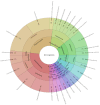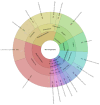Effect of Essential Oils and Dried Herbs on the Shelf Life of Fresh Goat Lump Cheese
- PMID: 38998522
- PMCID: PMC11241544
- DOI: 10.3390/foods13132016
Effect of Essential Oils and Dried Herbs on the Shelf Life of Fresh Goat Lump Cheese
Abstract
In recent years, the use of natural preservatives in food products has gained significant attention due to their potential health benefits and effectiveness. A standardized microbiological analysis was conducted on Slovak farm-produced lump goat cheese samples to determine the antibacterial activity of dry herbs and essential oils added to vacuum-packed goat cheese. We employed five dried herbs and five essential oils derived from the same plants. The microbiological quality of 145 fresh and vacuum-packed goat cheese samples was assessed. The number of coliform bacteria, total viable count, lactic acid bacteria, and microscopic filamentous fungi were examined in raw cheese samples stored for 12 days at 4 °C. All cheese samples were vacuum-packed (control samples were packed without vacuum). This study evaluated the potential benefits of using essential oils and dried herbs from thyme (Thymus serpyllum L.), black pepper (Piper nigrum L.), clove (Eugenia caryophyllus Thunb.), mint (Mentha × piperita L.), and basil (Ocimum basilicum L.) as preservatives. The essential oils were obtained from Hanus Ltd., Nitra, Slovakia, and were applied at a concentration of 2%. The dried herbs were obtained from Popradský čaj (Poprad, Slovakia) and Mäspoma Ltd. (Zvolen, Slovakia). The results showed that all microorganism groups were significantly reduced in cheese samples following the application of essential oils throughout the entire storage period. During the preservation of cheese samples in polyethylene bags used for vacuum packing food, Lactococcus garvieae, L. lactis, Enterobacter cloacae, and Serratia liquefaciens were the most frequently isolated microbiota. Essential oils and dried herbs demonstrated antimicrobial potential during the storage of vacuum-packed goat cheese.
Keywords: antimicrobial activity; food preservation; microbiological quality; microbiota of goat cheese; storage period.
Conflict of interest statement
The authors declare no conflicts of interest.
Figures










References
-
- Kleve R., Clark S. Goat and Sheep Cheeses. In: Clark S., Drake M., Kaylegian K., editors. The Sensory Evaluation of Dairy Products. Springer; Cham, Switzerland: 2023. pp. 571–587.
-
- Vanderzant C. Food Protection Technology. CRC Press; Boca Raton, FL, USA: 2018. Microbiological Criteria for Foods and Food Ingredients: A Review of the Report of the National Research Council; pp. 101–112.
-
- Oštarić F., Antunac N., Cubric-Curik V., Curik I., Jurić S., Kazazić S., Kiš M., Vinceković M., Zdolec N., Špoljarić J., et al. Challenging Sustainable and Innovative Technologies in Cheese Production: A Review. Processes. 2022;10:529. doi: 10.3390/pr10030529. - DOI
LinkOut - more resources
Full Text Sources

